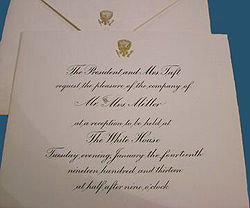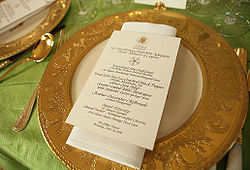
Graphics and Calligraphy Office
Encyclopedia



White House
The White House is the official residence and principal workplace of the president of the United States. Located at 1600 Pennsylvania Avenue NW in Washington, D.C., the house was designed by Irish-born James Hoban, and built between 1792 and 1800 of white-painted Aquia sandstone in the Neoclassical...
, the official residence
Official residence
An official residence is the residence at which heads of state, heads of government, gubernatorial or other senior figures officially reside...
of the president of the United States
President of the United States
The President of the United States of America is the head of state and head of government of the United States. The president leads the executive branch of the federal government and is the commander-in-chief of the United States Armed Forces....
. Located in the East Wing, the Graphics and Calligraphy Office coordinates and produces all non-political social invitations, place cards, presidential proclamations
Presidential Proclamation
A Presidential Proclamation is a statement issued by a President on a matter of public policy. They are generally defined as, "The act of causing some state matters to be published or made generally known...
, letters patent
Letters patent
Letters patent are a type of legal instrument in the form of a published written order issued by a monarch or president, generally granting an office, right, monopoly, title, or status to a person or corporation...
, military commissions
Officer (armed forces)
An officer is a member of an armed force or uniformed service who holds a position of authority. Commissioned officers derive authority directly from a sovereign power and, as such, hold a commission charging them with the duties and responsibilities of a specific office or position...
, and official greetings.
Organization
Headed by the White House Chief CalligrapherWhite House Chief Calligrapher
The White House Chief Calligrapher is responsible for the design and execution of all social and official documents at the White House, the official residence and principal workplace of the President of the United States....
, the Graphics and Calligraphy Office officially reports to the White House Chief Usher
White House Chief Usher
White House Chief Usher is the title of the head of household staff and operations at the White House, the official residence and principal workplace of the President of the United States....
, but works more closely with the Social Office, which is headed by the White House Social Secretary
White House Social Secretary
The White House Social Secretary is responsible for the planning, coordination and execution of official social events at the White House, the official residence and principal workplace of the President of the United States.-Function:...
, who is charged with the planning and coordination of official entertainment at the White House.
Official invitations
The design of White House invitations has evolved over time. Dinner invitations going back to the administration of John AdamsJohn Adams
John Adams was an American lawyer, statesman, diplomat and political theorist. A leading champion of independence in 1776, he was the second President of the United States...
, the first president to live in the White House, are archived and have inspired the current invitations. In President Adams' day invitations were letterpress printed with the passage reading "The President of the United States, requests the Pleasure of ______'s Company to Dine, on_____next at ___ o'Clock." Space allowed for the hand penned insertion of "& Mrs. Adams" if the First Lady were to attend, as well as individual guests' names, and the date and time. A flowing round hand
Round hand
Round Hand is a type of handwriting and calligraphy originating in England in the 1660s primarily by the writing masters John Ayers and William Banson...
type of penmanship was used. This style of writing was found in writing manuals in the 18th century.
The custom of including a representation of the arms of the United States, by way of an eagle clutching an olive branch and arrows in its talons and a striped shield with stars became standard on invitations in the early 19th century. By the mid 19th century the more formal Great Seal of the United States
Great Seal of the United States
The Great Seal of the United States is used to authenticate certain documents issued by the United States federal government. The phrase is used both for the physical seal itself , and more generally for the design impressed upon it...
was placed at the head of invitations. Text was engraved in black script, allowing space for the guest's name to be added individually. The Great Seal was engraved in burnished gold.
In 1880 President Rutherford B. Hayes
Rutherford B. Hayes
Rutherford Birchard Hayes was the 19th President of the United States . As president, he oversaw the end of Reconstruction and the United States' entry into the Second Industrial Revolution...
had a new seal created for the presidency. The new Seal of the President of the United States
Seal of the President of the United States
The Seal of the President of the United States is used to mark correspondence from the U.S. president to the United States Congress, and is also used as a symbol of the presidency. The central design, based on the Great Seal of the United States, is the official coat of arms of the U.S...
shared similarities with the nation's Great Seal. Initially the new presidential seal was applied to seal documents and the presidential flag. In 1902 President Theodore Roosevelt
Theodore Roosevelt
Theodore "Teddy" Roosevelt was the 26th President of the United States . He is noted for his exuberant personality, range of interests and achievements, and his leadership of the Progressive Movement, as well as his "cowboy" persona and robust masculinity...
had the presidential seal applied to stationery and invitations in lieu of the Great Seal. The style of invitations became codified with few changes to the present.
Official greetings, proclamations and commissions
While much of the work of the Graphics and Calligraphy Office is centered on social events, the office also engrosses official documents including military commissions, presidential awards, appointments and proclamations.Further reading
- Clinton, Hillary Rodham. An Invitation to the White House: At Home with History. Simon & Schuster: 2000. ISBN 0-684-85799-5.
- Garrett, Wendell. Our Changing White House. Northeastern University Press: 1995. ISBN 1-55553-222-5.

